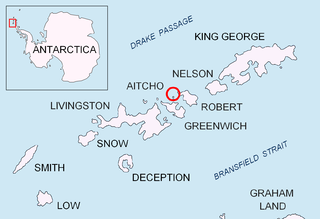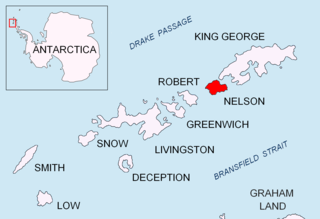
The South Shetland Islands are a group of Antarctic islands with a total area of 3,687 km2 (1,424 sq mi). They lie about 120 kilometres north of the Antarctic Peninsula, and between 430 and 900 km southwest of the nearest point of the South Orkney Islands. By the Antarctic Treaty of 1959, the islands' sovereignty is neither recognized nor disputed by the signatories and they are free for use by any signatory for non-military purposes.

The Fildes Peninsula is a 7 km (4.3 mi) long peninsula that forms the south-western end of King George Island in the South Shetland Islands of Antarctica. It was named from association with nearby Fildes Strait by the UK Antarctic Place-Names Committee in 1960; the strait was likely named for Robert Fildes, a British sealer of the 1800s.
Pendulum Cove is a cove at the north-east side of Port Foster, Deception Island, in the South Shetland Islands of Antarctica. The name of the cove derives from the pendulum and magnetic observations made there by the British expedition under Henry Foster in 1829.

Yankee Harbour is a small inner harbour entered from Shopski Cove between Glacier Bluff and Spit Point, indenting the south-west side of Greenwich Island in the South Shetland Islands, Antarctica. It is 2.35 km (1.46 mi) long in west-south-west to east-north-east direction, and 1.6 km (0.99 mi) wide, and is bounded by Provadiya Hook to the south-west, Parvomay Neck to the north and east, and Kladara Beach to the south.

Inott Point is a point 1 nautical mile (2 km) north-northeast of Edinburgh Hill forming the eastern extremity of Varna Peninsula on Livingston Island in the South Shetland Islands, Antarctica. Situated 4.3 km southwest of Bagryana Point on Greenwich Island across McFarlane Strait. In association with the names of nineteenth century sealers in this area, it was named by the UK Antarctic Place-Names Committee after Captain Robert Inott, Master of the American sealing ship Samuel from Nantucket, who visited the South Shetland Islands in 1820–21.

Express Island is a narrow and craggy island, 1.23 kilometres (0.76 mi) long, lying close offshore of northwest Greenwich Island in the South Shetland Islands, Antarctica. It is situated due north of Greaves Peak, forming most of the east side of Razlog Cove. Surface area 29 hectares.

John Beach is a beach on the west side of the entrance to Walker Bay on the south coast of Livingston Island, in the South Shetland Islands. The ice-free area is around 109 hectares.

Essex Point is a point at the northwest end of Byers Peninsula, Livingston Island in the South Shetland Islands, Antarctica. It forms the west side of the entrance to Barclay Bay and the northeast side of the entrance to Svishtov Cove, and is surmounted by Drong Hill.

Emeline Island is a conspicuous rocky island rising to over 100 m (328 ft) in the Aitcho group on the west side of English Strait in the South Shetland Islands, Antarctica. The island extends 550 by 320 m with a surface area of 18 hectares. The area was visited by early 19th century seal hunters.

Lynx Rocks is a group of rocks in southwestern Hero Bay on the north side of Livingston Island in the South Shetland Islands, Antarctica. The area was visited by early 19th century sealers operating from nearby Blythe Bay.

Liberty Rocks is a group of four prominent adjacent rocks lying at the north entrance to Nelson Strait in the South Shetland Islands, Antarctica and extending 430 by 120 m. The area was visited by early 19th-century sealers.

Argentina Glacier is a glacier flowing northwest from Hurd Dome and terminating near Argentina Cove, South Bay, on Livingston Island, in the South Shetland Islands. The name Argentina Glacier was given in association with Argentina Cove by the Spanish Antarctic Expedition, about 1995.

Richards Cove is the 450 m wide cove indenting for 550 m the north coast of Ray Promontory, Byers Peninsula, Livingston Island in the South Shetland Islands, Antarctica, entered east of Aglen Point and west of Voyteh Point. The area was visited by early 19th century sealers.

Caraquet Rock is a rock lying nearly 4 nautical miles (7 km) west-southwest of Bell Point, off the west part of King George Island in the South Shetland Islands. It was named by the UK Antarctic Place-Names Committee in 1960 for the sealing vessel Caraquet from Liverpool, which visited the South Shetland Islands in 1821–22.

Nancy Rock is a rock lying 2 nautical miles (3.7 km) west of Flat Top Peninsula, King George Island, in the South Shetland Islands. Named by the United Kingdom Antarctic Place-Names Committee (UK-APC) in 1961 after the American sealing vessel Nancy from Salem, MA, which visited the South Shetland Islands in 1820–22.

Weeks Stack is a sea stack lying off the north tip of Nelson Island in the northern approach to Fildes Strait, in the South Shetland Islands. Situated 635 m north-northeast of Cariz (Agrelo) Point. Named by the United Kingdom Antarctic Place-Names Committee (UK-APC) in 1961 for Captain Weeks, Master of the British sealing vessel Horatio from London, who visited the South Shetland Islands in 1820–21.

Folger Rock is a rock lying 2.5 nautical miles (5 km) north of Harmony Point, Nelson Island, in the South Shetland Islands. It was named by the UK Antarctic Place-Names Committee in 1961 for Tristan Folger, the Master of the American sealing vessel William and Nancy from Nantucket, which visited the South Shetland Islands in 1820–21, operating from nearby Harmony Cove.

Harmony Point is a point which lies close west of Harmony Cove and forms both the south side of the entrance to Malak Sechko Cove and the western extremity of Guangzhou Peninsula and Nelson Island, in the South Shetland Islands of Antarctica. It was charted in 1935 by Discovery Investigations personnel on the Discovery II, and named from association with Harmony Cove.

Livonia Rock is a rock lying 0.5 nautical miles (1 km) south of Cape Melville, the eastern extremity of King George Island, in the South Shetland Islands, Antarctica. It was named by the UK Antarctic Place-Names Committee in 1960 for the sealing vessel Livonia from London, which visited the South Shetland Islands in 1821–22.

Guangzhou Peninsula is the mostly ice-free peninsula forming the west extremity of Nelson Island in the South Shetland Islands, Antarctica and ending up in Harmony Point. It is bounded by Harmony Cove and Nelson Strait on the south and southwest, and Malak Sechko Cove and Golyam Sechko Cove in Drake Passage on the northwest, extends 3.4 km in northeast–southwest direction and 2.7 km in southeast–northwest direction, and has a surface area of 5.02 km2. The area was visited by early 19th century sealers based at Harmony Cove.












